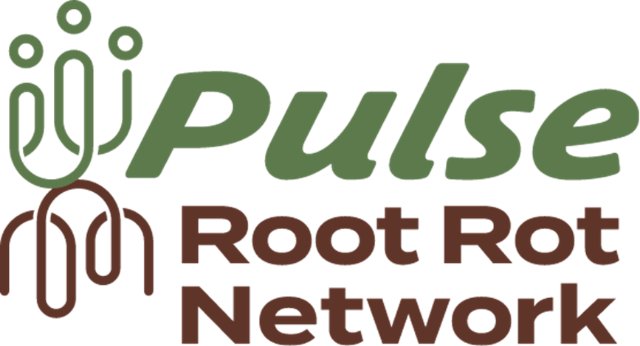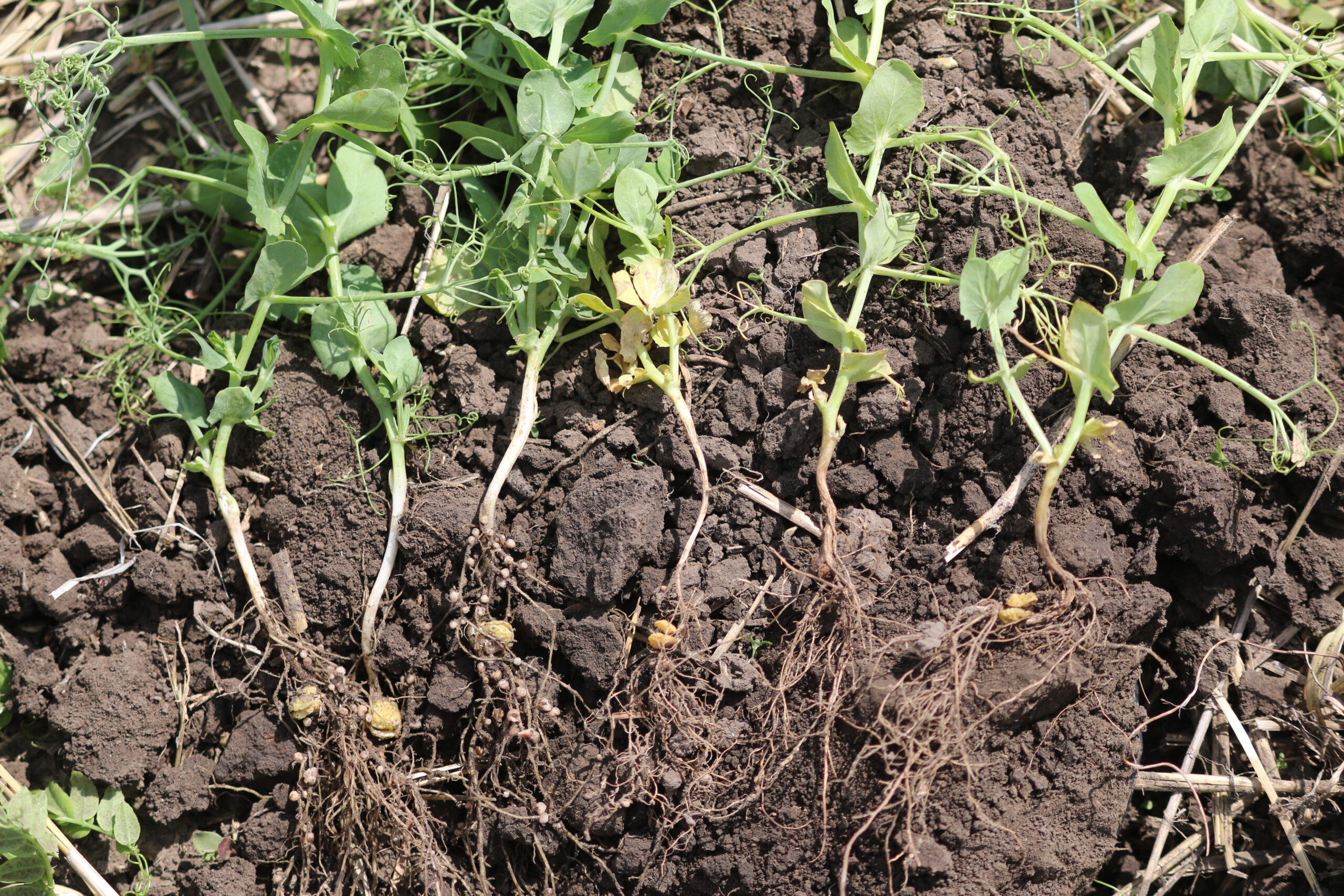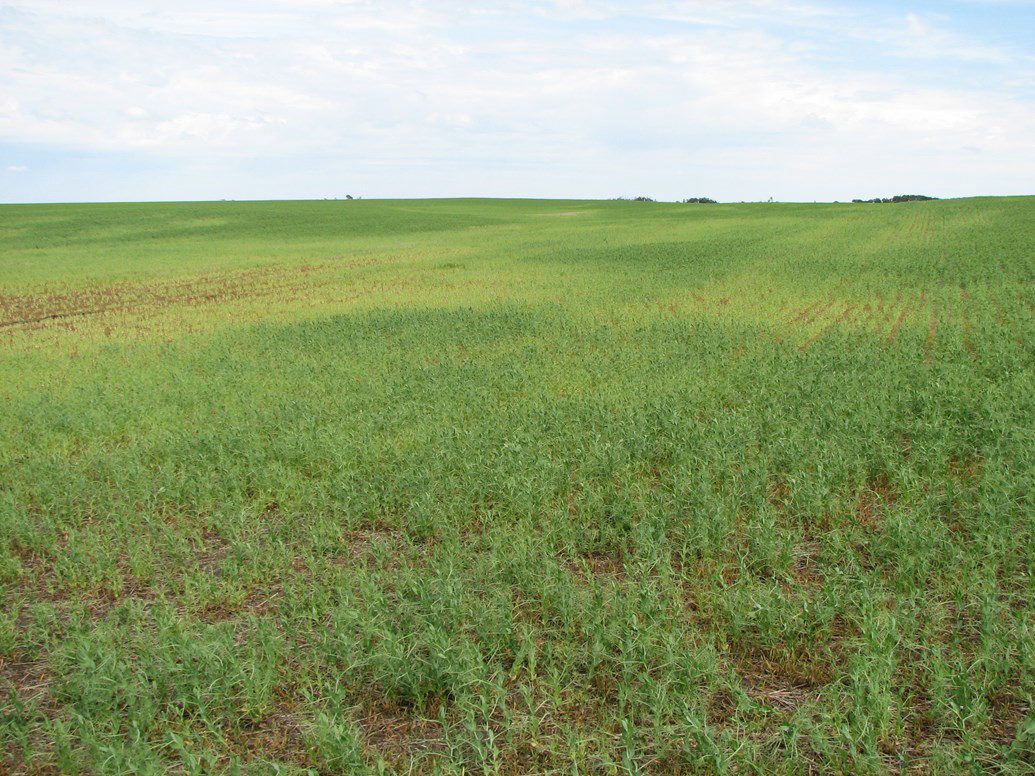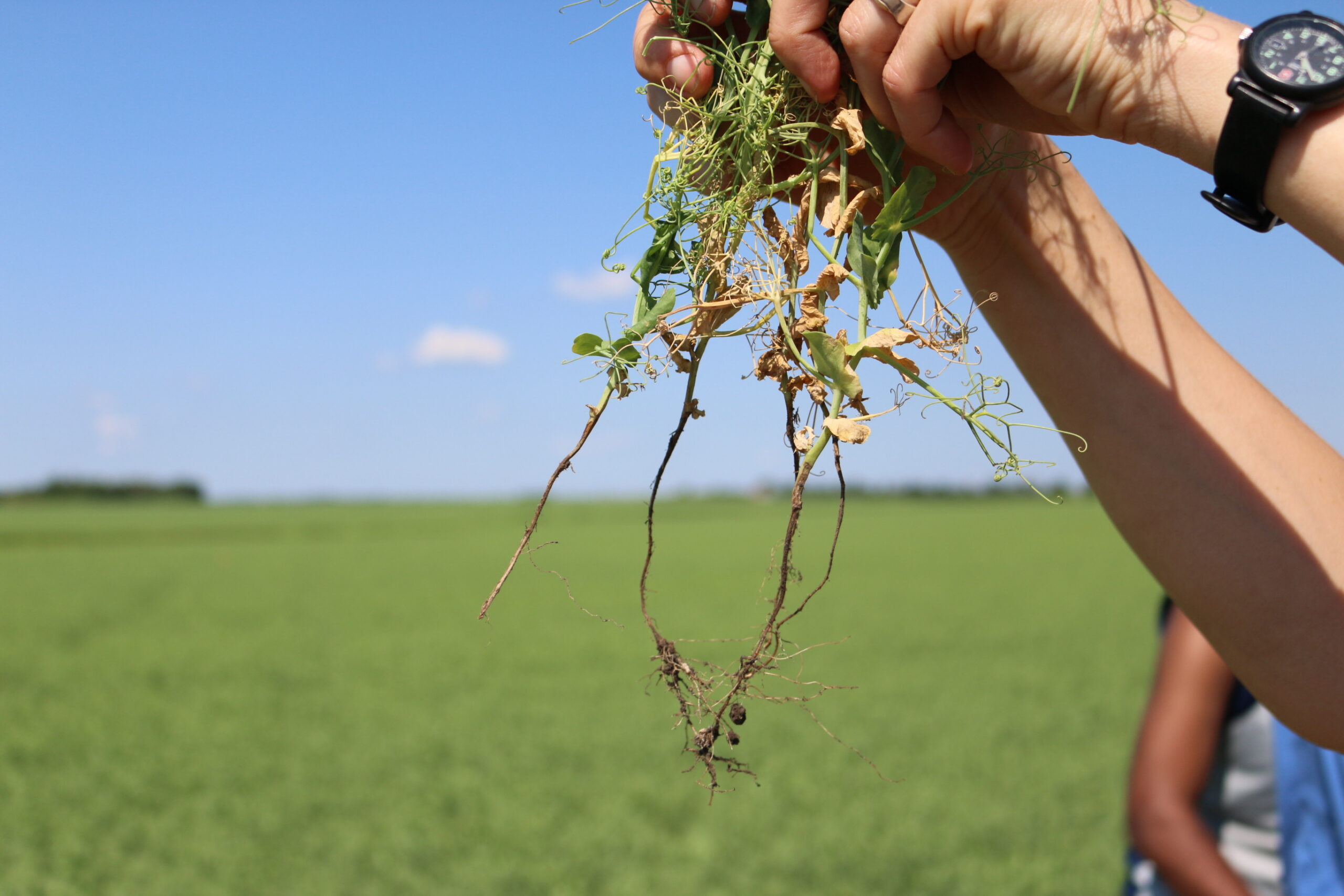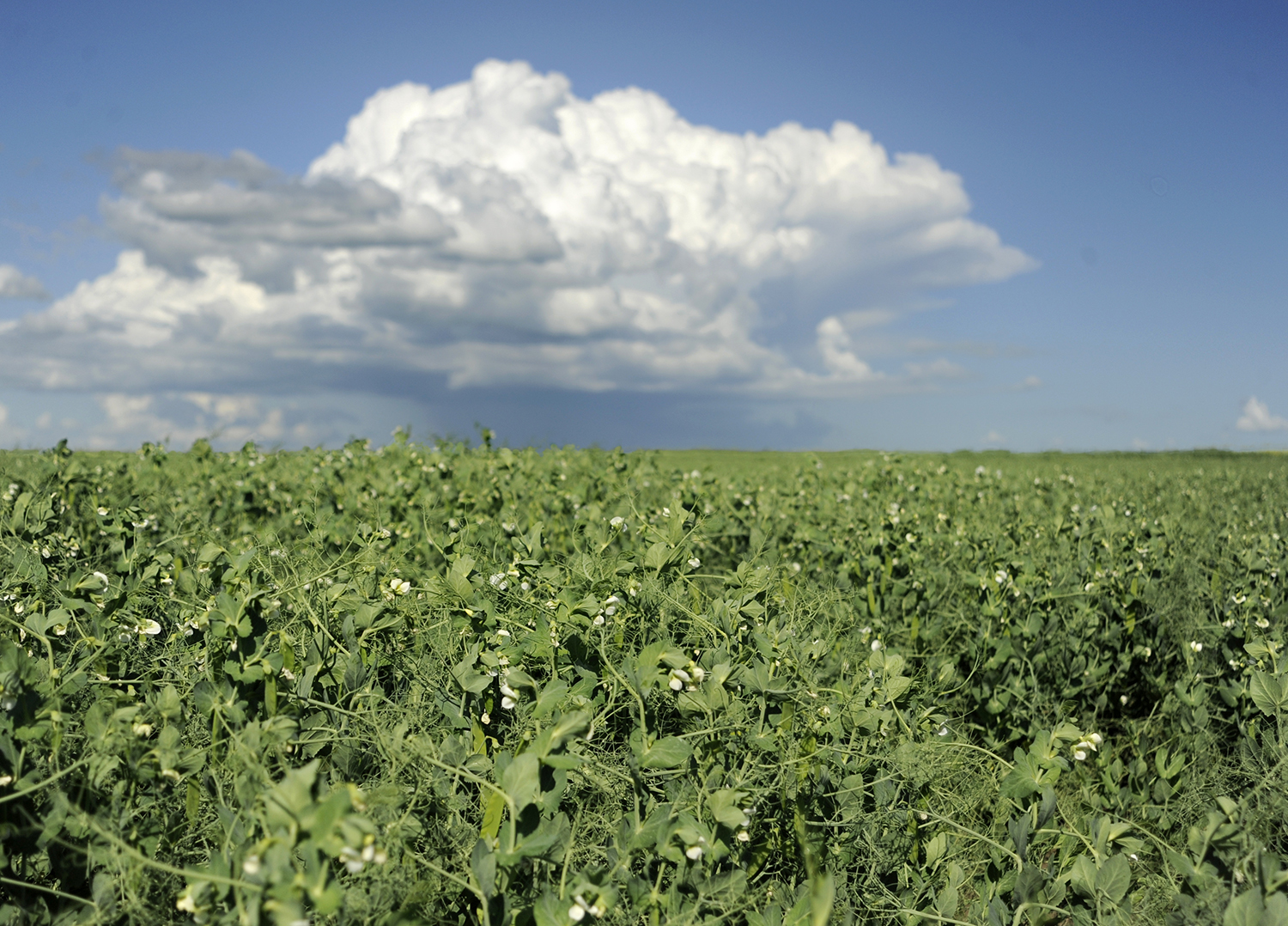Surveys across Western Canada have found two main pathogens responsible for root rots in pulses. Fusarium species are distributed widely, with F. avenaceum and F. solani the most virulent types of root rot that can cause yield loss. Aphanomyces euteiches, first reported in Saskatchewan in 2012, is a more recent concern.
Aphanomyces root rot is most common under good soil moisture conditions. The pathogen is a water mould that depends on moisture for the zoospores to move in the soil and infect plant roots. Infection can happen anytime during the growing season, and spores can persist for many years in the soil. Root rots may still show up in drier growing conditions and may or not be Aphanomyces root rot.
The seedling stage seems to be the most susceptible for Fusarium root rot, but symptoms do not typically become visible until late flower. In drier years, root rot symptoms showing up later in the season may be caused by one of many different pathogens.
Aphanomyces root rot is very difficult to identify and isolate with conventional methods and requires a DNA test for confirmation. For fields with a history of root rot, recommendations are for growers to test their fields for the presence of A. euteiches so that they can implement practices to manage the disease if is present.
Several labs in Western Canada can test for the Aphanomyces root rot pathogen. These labs may analyze either root tissue or a soil sample.
While each lab has its own sampling and submission protocol, the following are general recommendations for soil and plant sampling: Soil analysis can be performed as a direct soil extraction or as a bait test. A soil bait test, offered by several commercial labs, utilizes germinating seedlings of an Aphanomyces host crop that are planted into the soil sample to induce Aphanomyces oospore germination. This test method has been shown to provide the most consistent results when testing soil for Aphanomyces. One of the challenges that still exist, however, is determining Aphanomyces levels in dry, heavier-textured soils, which under current analysis techniques, have a greater frequency of producing false negative results.
To address this issue, Saskatchewan Pulse Growers (SPG) collected soil samples from 12 lentil fields in Saskatchewan at in-crop and post-harvest timing at three different landscape positions (hilltop, midslope, and depression) in 2022. This project aimed to identify differences in Aphanomyces (quantitative) and Fusarium spp. (qualitative) disease pressure at these landscape positions. Samples were analyzed using the current Aphanomyces oospore detection methods commercially available to growers (direct soil extraction, bait test, and plant tissue extraction from in-crop plant samples) to determine which method produces the most consistent and accurate results. SPG also added a 28-day bait test method with an extended incubation period on the post-harvest samples to determine if longer periods of saturation improved Aphanomyces and Fusarium species detection in dry, drought-ridden soils. The goal of this project was to evaluate which sample collection timing, landscape position, and laboratory testing method are optimal for growers to determine the infection risk for future pea or lentil crops.
Each sample was screened for Aphanomyces eutieches, F. avenaceum, F. oxysporum, F. redolens, and F. solani through DNA quantitative polymerase chain reaction (qPCR) analysis. As expected, the 28-day bait tests had higher levels of Aphanomyces in the tissue compared to the 7-day bait tests. In comparison, the direct soil extractions did not consistently detect Aphanomyces present in the soil. Soil bait testing is currently the best method for detecting Aphanomyces oospores. Longer incubation periods beyond 7 days, targeting anywhere from 10-21 days, produce the most consistent Aphanomyces DNA results to date. When soil bait tests were conducted for 28 days, some of the host pea plants began to die from root rot infection around 21 days after planting. In these cases, the incubation had to be terminated early to conduct the DNA extraction. The most consistent results were from the 28-day bait test where all samples tested positive for Aphanomyces DNA. Comparatively, as seen in Figure 1, the post-harvest 7-day soil bait test, the in-crop soil bait, and plant tissue extraction detected Aphanomyces in 75-83% of the samples tested. Both direct soil DNA extractions (no saturation period and no host plant present) produced the worst results, only detecting Aphanomyces DNA in 50-58% of the samples.

Aphanomyces was detected at all landscape positions for all samples by every laboratory method except direct soil extraction at post-harvest (Figure 2). When comparing landscape positions and Aphanomyces incidence we found the greatest Aphanomyces in the depressions and surprisingly high incidence in the midslope position as well (Figure 2). Even though Aphanomyces was detected at all landscape positions the severity of the infection is not reflected in Figure 2 Root rot infections were significantly worse across the gradient of landscape positions where depression samples were most severely infected, followed by intermediate disease severity at the midslope position and mild infection levels at the hilltop positions.

When determining root rot infection severity and risk, it is important to determine the last time a host crop (pea or lentil) was grown in a particular field and the moisture conditions that year. Figure 3 illustrates the gradient of disease severity across landscape positions of two different fields in Saskatchewan during the summer of 2022. Both fields had lentils grown three times since 2011, however field a) was seeded to durum in 2016 while field b) was seeded to lentils. As shown in Figure 3, the plants from field b) had more severe disease infections than those from field a) illustrating the impact environmental conditions play in compounding the risk of an Aphanomyces root rot infection in future years.

Aphanomyces eutieches infections do not often occur alone, but in conjunction with other root rot pathogens, particularly Fusarium species. The Fusarium species of greatest concern in pulses are F. avenaceum, F. oxysporum, F. redolens, and F. solani. Plant tissue tests and the 28-day soil bait test consistently detected Fusarium spp. infections (Figure 4). Incidence of Fusarium infections were not impacted by landscape position (Figure 4), however, similar disease severity to Aphanomcyes infections was observed where disease severity was worst in the depressions > midslope > hilltops.

Overall, we determined longer incubation periods (10-21 days) for soil analysis to detect root rot pathogens are recommended when soils are dry, particularly from fall collected samples, dry, or heavier textured soils. If a lab is unable to conduct a longer incubation period with their current soil bait testing method, conducting the 7-day soil bait test is the next most reliable method for determining the presence of Aphanomyces in soil. Landscape position correlates with disease incidence and severity where the worst infections occur in the depressions followed by the midslopes and then the hilltops. Fusarium spp. incidence does not consistently correspond to landscape position and the best detection method is plant tissue testing followed by longer incubation soil bait testing.
Sampling Methods
Soil
- Sample in a W-shaped pattern across entire field or focus on taking samples from low spots, water runs, compacted areas, or other suspect areas where yellowing and poor growth in previous pea or lentil crops was noted.
- Collect a four to eight inch (10 to 20 centimetres) deep soil sample from the surface A-horizon layer, or less as depth allows, without taking any of the B-horizon subsoil. Do not include thatch or surface residue layers in the sample.
- Submit a minimum soil sample volume of two cups.
Plant Tissue
- Infected plants are concentrated sources of pathogen and represent a significant escalation in the amount of inoculum present in a field.
- Scout for suspect plants showing signs of root rots such as wilting, yellowing of the plant, and discoloured roots. Submit root tissue only (fresh, dried, or frozen) for testing.
- Some labs provide their own sample kit. Contact the lab for their specific sampling protocols and submission requirements.
What The Results Mean

The results from a lab test in the fall can mean several things depending on the reporting lab. The first is positive or negative. This simply means that the pathogen is present in the sample but does not put a number on the amount of spores per gram of soil, or level of infection of the root tissue.
Some labs take the positive/negative test one step further in their reporting, where a positive result means that the pathogen is present at levels that would be capable of causing disease. A negative result cannot guarantee that the pathogen is not present in the field, but just not present in the soil sample.
Finally, some labs provide a quantitative result reporting on the number of spores per gram of soil or levels of risk for root rots. Previous research by Agriculture and Agri-Food Canada had suggested higher risk for A. euteiches in fields when levels are above 100 oospores per gram of soil in the Dark Brown soils, and 750 oospores per gram in the Brown and Black soils. However, the presence of Fusarium spp., particularly in Brown soils, increases disease severity. Because Fusarium spp. are so widespread on the Prairies, the risk threshold for A. euteiches has been adjusted. The number of A. euteiches oospores where the pathogen may start to cause an impact on the crop has been set at 100 oospores per gram of soil for all soil types.
If A. euteiches is confirmed in a field, growers should follow recommended management practices that include rotating to non-susceptible crops or more tolerant pulse crops such as faba beans, chickpeas, or soybeans, and maintaining a minimum of six to eight years between susceptible hosts such as peas, lentils, and alfalfa. Growers and agronomists are encouraged to sample across the landscape, particularly targeting the high-risk areas (depressions), and pairing root rot disease incidence and severity assessments on plant samples with soil bait test results, cropping history and historical weather data when evaluating future Aphanomyces and root rot infection risks.
Labs Offering Soil and/or Plant Specimen Analysis for Root Rot Pathogens
- 20/20 Seed Labs: Pea Root Rot Test on plant specimens through plating for Fusarium species, Pythium species, and Rhizoctonia solani, in addition to DNA extraction for Aphanomyces euteiches. This test can be done on other pulse crops besides just peas. Requires at least five plants and provides the percentage of infection by each pathogen. Soil test results are based on extraction of oospores from soil and DNA analysis for Aphanomyces only. Results are reported as positive or negative. A positive result means the pathogen is present at levels capable of causing the disease.
- A & L Canada Labs: Plant specimens and soil are subjected to DNA extraction and polymerase chain reaction (PCR) analysis to detect various pathogens including the root rot pathogens Aphanomyces eutiches, Fusarium oxysporum, F. solani, Pythium, and Rhizoctonia solani. Results presented in semi-quantitative analysis (low, moderate, high).
- AFL Agriculture & Food Laboratory: Plant specimen and soil are subjected to DNA extraction and PCR analysis to detect various pathogens including root rot pathogens. Aphanomyces eutiches and Rhizoctonia solani as well as various Fusarium and Pythium species. Results presented quantitatively and identified as low, moderate, and high levels.
- BDS Laboratories: Plant specimen and soil samples are plated and the cultures produced are identified. Pathogens able to detect including root rot pathogens Aphanomyces eutiches, Fusarium, Pythium, and Rhizoctonia. Results presented as detect or not detected.
- Discovery Seed Labs: Plant specimens are analyzed for Aphanomyces through DNA extraction and reported as detected or not detected. Fusarium is also screened for as requested. Soil tests use both DNA extraction directly from the soil as well as from roots grown in the Bait test. Bait testing involves growing germinated pea seedlings in submitted soil for seven days and then extracting the DNA from the roots to screen for pathogens. The combination of the tests are used to confirm Aphanomyces eutiches presence. Fusarium can also be identified in the roots from the Bait test but is not reported to the species level. Results are reported as detected or not detected and the lab will assist with interpretation or further risk analysis based on individual results. Discovery Seed Labs has the ability to quantify the number of oospores per gram of soil and have done some quantitative reports for agronomists/farmers to establish a baseline for a field to allow monitoring over time.
- Quantum Genetix: Q Protect kits are available from select retailers for submitting and detecting presence of organisms in soil or plant tissues. Detection or quantification is offered for Aphanomyces, Fusarium avenaceum, and Rhizoctonia as well as for root rot complex. The test uses DNA extraction and PCR techniques for detection and quantification and can provide the number of oospores per gram of soil.
- SGS BioVision: Plant specimen and soil are subjected to DNA extraction and PCR analysis to detect various pathogens including root rot pathogens Aphanomyces eutiches, Fusarium, Pythium, and Rhizoctonia. For soil, results are expressed as detected if all replicates have detectable PCR product greater than 100 oospores/gram of soil, otherwise the result will be reported as not detected. For root tissue, results are expressed as detected or not detected.
